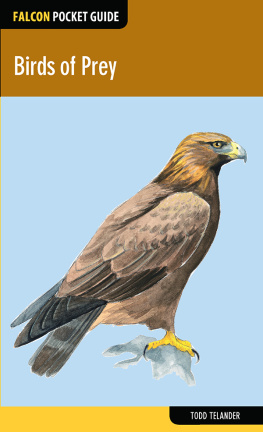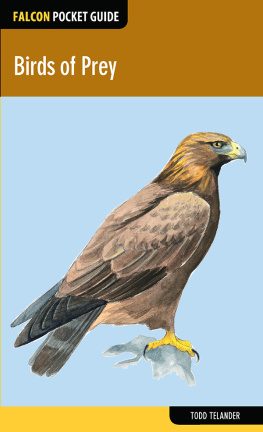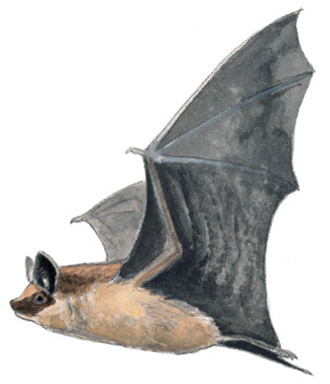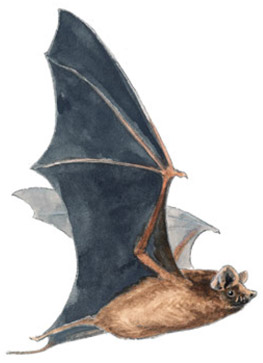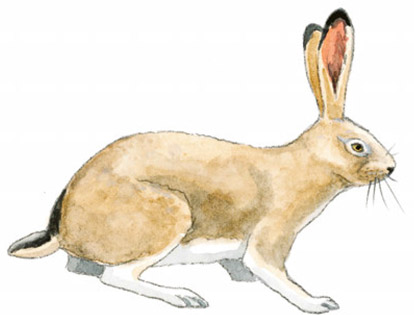About the Author/Illustrator
Todd Telander is a naturalist/illustrator/artist living in Walla Walla, Washington. He has studied and illustrated wildlife since 1989 while living in California, Colorado, New Mexico, and Washington. He graduated from the University of California, Santa Cruz, with degrees in biology, environmental studies, and scientific illustration, and has since illustrated numerous books and other publications, including books in FalconGuides Scats and Tracks series. His wife, Kirsten Telander, is a writer, and they have two sons, Miles and Oliver. His work can be viewed online at toddtelander.com or telandergallery.com.
MAMMALS
Virginia Opossum, Didelphis virginiana
Family Didelphidae (Opossums)
Size: 30" with tail
Range: Central and eastern United States; portions of Pacific states
Habitat: Woodlands, riparian zones, urban areas with trees, farms
The Virginia Opossum is a marsupial, meaning it bears premature young that develop in an external pouch, and is the only member of this group in North America. It is stocky, with relatively small limbs, a pointed snout, and a long, round, hairless tail. Its color is mottled grayish, with a white face and dark ears. It is nocturnal, mostly solitary, and reasonably adept at swimming and climbing. It has a highly varied diet that includes nuts, fruit, insects, small animals, and carrion. Opossums have a curious habit of feigning death when under attack, then resuming as normal once safe.
Southern Short-tailed Shrew, Blarina carolinensis
Family Soricidae (Shrews)
Size: 3-5" long with tail
Range: Southeastern United States
Habitat: Moist woodlands, brushy areas
Shrews are the smallest mammals in North America and are unrelated to the rodents. The Southern Short-tailed Shrew is very active. It is shaped like a long mouse, with a sharply pointed head, tiny eyes, no external ears, and a short, lightly furred tail. Its fur is dense, dark gray above and slightly paler below. This shrew is active day and night, mostly solitary, and utilizes an extensive network of tunnels, which it digs itself. Voracious feeders, shrews forage within their tunnels and nearby leaf litter for insects, earthworms, spiders, small invertebrates, and sometimes nuts and seeds. Shrews can also secrete poisonous saliva that paralyzes prey.
Eastern Mole, Scalopus aquaticus
Family Talpidae (True Moles)
Size: 6" long with tail
Range: Central and eastern United States
Habitat: A variety, including fields, woodlands, lawns, and areas with dry, loose soils
Also known as the Common Mole, the Eastern Mole is a small, stocky, sturdy mammal with a body well designed for life underground. It is elongate and tube-shaped, with narrow hips, a pointed, fleshy snout, and a short tail. Its fur is short, velvety, deep gray brown above and slightly paler below. Its eyes are tiny and covered by skin, and its ears are invisible beneath its fur. Eastern Moles build tunnels, which they dig with their broad, spade-like forelimbs and long, thick claws. They forage within the tunnels for earthworms, insects, and some plants. Eastern moles are responsible for creating conspicuous dirt mounds at the entrances to their tunnels.
Big Brown Bat, Eptesicus fuscus
Family Vespertilionidae (Vespertilionid Bats)
Size: 5" with tail
Range: Throughout the contiguous United States
Habitat: A wide variety, including woodlands, buildings, and caves
As a group, bats are the only mammals that truly fly, using wings made of a thin membrane stretched across elongate forearms and fingers. The Big Brown Bat is widely distributed. It is fairly large, with fur that is brown above and lighter below, with blackish wing membranes. There is a fleshy projection at the base of the ear (the tragus), which is short and rounded. Big Brown Bats are nocturnal, roosting by day in dark, secluded areas such as caves or old buildings. They emerge at night to forage for beetles and other insects, locating them primarily by echolocation, emitting high-pitched chirps and receiving reflected sound with their complex, large ears.
Brazilian Free-tailed Bat, Tadarida brasiliensis
Family Molossidae (Free-Tailed Bats)
Size: ~4" with tail
Range: Throughout the contiguous United States
Habitat: Caves, buildings, and surrounding environs
Also known as the Mexican Free-tailed Bat or Guano Bat, the Brazilian Free-tailed Bat is small, with narrow wings and a tail that projects freely about halfway past the interfemoral membrane, a patch of skin that stretches between the legs. Its fur is rich brown, slightly darker above than below, and its wings are blackish. The ears are broad, reaching forward on the face, and the upper snout is wrinkled. Brazilian free-tailed bats emerge from roosting sites at night in large groups and forage in the air for a variety of insects, using echolocation to zero in on prey. These bats are among the most numerous mammals in the United States, famous for gathering in enormous concentrations in caves in New Mexico and for depositing deep accumulations of guano in those caves.
Black-tailed Jackrabbit, Lepus californicus
Family Leporidae (Rabbits and Hares)
Size: ~23" long
Range: Western United States
Habitat: Prairies, open sage land, meadows
The black-tailed jackrabbit is a large, lanky hare with relatively long legs and huge, black-tipped ears. The color is gray brown, paler underneath, with a white tail that has a black stripe on top that extends onto the rump. The similar white-tailed jackrabbit has no dark upper surface on the tail and inhabits the mountains of eastern California. Jackrabbits are mostly nocturnal and solitary, highly alert, and able to elude predators with exceptionally fast runs and high jumps. They forage on grass and other vegetation, but may be limited to bark and buds in winter.
Eastern Cottontail, Sylvilagus floridanus
Family Leporidae (Rabbits and Hares)


